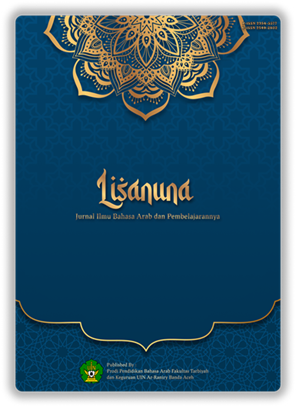MAN 4 Aceh Besar في تدريس الاستماع بـــ Fun Easy Learn Arabic استخدام برنامج
DOI:
https://doi.org/10.22373/ls.v14i2.26885Keywords:
Fun Easy Learn Arabic Aplication, Teaching ListeningAbstract
From observations conducted by the researcher at MAN 4 Aceh Besar, it was revealed that Arabic language teachers only use textbooks and PowerPoint presentations, apply selective teaching methods, and strive to teach Arabic well. However, students feel bored and uninterested in learning Arabic, especially in listening lessons, which makes it difficult for them to understand the material being taught. The researcher found that students have difficulty in remembering vocabulary, perhaps due to the lack of suitable teaching methods for teaching listening skills. Therefore, the researcher aims to develop students' abilities in learning Arabic, especially in listening lessons. Thus, the researcher wrote this thesis entitled "The Use of Fun Easy Learn Arabic Application in Teaching Listening". The aim of this research is to determine the effectiveness of using the Fun Easy Learn Arabic Application in teaching listening. In this study, the researcher used an experimental research method, known as the One Group Pre-test Post-test Design. The tools used to collect data were a test list, namely pre-test and post-test. Data analysis used the Wilcoxon Sign Rank Test, which showed a significance level Sig. (2-tailed) of 0.00, lower than the significance level of 0.05, indicating that the alternative hypothesis (Ha) was accepted and the null hypothesis (H0) was rejected.
Downloads
References
البعلبكي روحي، المورد قاموس عربي – إنكليزي، الطبعة الثامنة عشرة (بيروت : دار العلم للملايين، 2113 م) ص. 12
الخميس، عبد الرحمن بن صالح، فن الاستماع وطرق تدريسه واختباره، ص. 5
السحاطة حسان، تعليم اللغة العربية بين النظرية للناطقين باللغة والتطبيق، (بيروت: الدار المصرية اللبننية،
، ص. 78
العاسف، صالح ابن أحمد، المدخل إلى البحث في العلوم السلوكية، الطبعة الثانية، (الرياض: المكتبة العبيكان، 2000 م)، ص.303.
صالح ابن أحمد العاسف، المدخل إلى البحث ...، ص.315
صالح ابن أحمد العاسف، المدخل إلى البحث في العلوم السلوكية، ...، ص. 406
طعيمة رشدي أحمد ومحمد السيد، تدريس العربية في التعليم العام نظريات وتجارب الطبعة الأولى (دار الفكر العربي: 1420-2000)، ص. 79
عمر أحمد مختار، معجم اللغة العربية المعاصرة، الطبعة الأولى، (القاهرة: عالم الكتب، 2111 م) ص. 129
لافي سعيد، تعليم اللغة العربية المعاصرة، (ط1، القاهرة: عالم الكتب، 2015 م) ص. 128-129
لافي سعيد، تعليم اللغة العربية... ، ص. 123
معلوف لوبس، المنجد في اللغة والإعلام، الطبعة الثانية والعشرون، (بيروت: دار المشرق، 1987)، ص. 26
معلوف لويس، معجم المنجد في اللغة والأعلام، الطبعة الثالثة والأربعون (بيروت: دار المشرق، 2008 م) ص. 900
المراجع الإندونيسية
Arikunto Suharsimi, Dasar-Dasar Evaluasi Pendidikan, Hal. 281
Arsyad Azhar, Media Pembelajaran, Jakarta (PT. Raja Grafindo: 2011), Hal: 3-4
https://carisinyal.com/aplikasi-belajar-bahasa-arab/, diakses pada tanggal 01 Desember 2023, Pukul 10:56.
Ismani Ahmad Faizul Walida, Hanik Mahliatussikah. 2020. Jurnal Lisanuna, Vol. 10, No.1 (2020), Hal. 15
Ismani Ahmad Faizul Walida, Hanik Mahliatussikah. 2020. Jurnal Lisanuna, Vol. 10, No.1 (2020), Hal. 16
Nisa Vividia Choirun, Pembelajaran Istima’ pada Aplikasi Arab Fun Easy Learn (Studi Analisis Konten Menurut Standar (ACTFL), https://journal.nabest.id/index.php/annajah/article/view/122, diakses pada Tgl 01 Desember 2023, Pukul 10:30
https://journal.nabest.id/index.php/annajah/article/view/122, diakses pada Tgl 01 Desember 2023, Pukul 10:30
Sugiyono, Metode Penelitian Kuantitatif, Kualitatif, dan R&D, (Bandung: Alfabeta, 2013) Hal: 85.
Sumiarni Nanin, Aziz Syafruddin Syafrawi, Efektifitas Pembelajaran Menyimak dan Berbicara Untuk Pemula (Maharat Al-Istima’ Wa Al-Kalam Lil Mustawa Al-Tamhidi) Berbasis KKNI Pada Mahasiswa Jurusan Pendidikan Bahasa Arab (PBA) IAIN Syekh Nurjati Cirebon, Jurnal Pendidikan Bahasa Arab: El-Ibtikar. 2019.
Tim Penyusunan, Panduan Akademik dan Penulisan Skripsi Fakultas Tarbiyah dan Keguruan UIN Ar-Raniry Banda Aceh Tahun 2016, (Banda Aceh: FTK Ar-Raniry Press, 2016), Hal. 155-164.
Downloads
Additional Files
Published
Issue
Section
License
1. Proposed Policy for Journals That Offer Open Access Authors who publish with this journal agree to the following terms:
1.a. Authors retain copyright and grant the journal right of first publication with the work simultaneously licensed under a Creative Commons Attribution License that allows others to share the work with an acknowledgement of the work's authorship and initial publication in this journal.
1.b. Authors are able to enter into separate, additional contractual arrangements for the non-exclusive distribution of the journal's published version of the work (e.g., post it to an institutional repository or publish it in a book), with an acknowledgement of its initial publication in this journal.
1.c. Authors are permitted and encouraged to post their work online (e.g., in institutional repositories or on their website) prior to and during the submission process, as it can lead to productive exchanges, as well as earlier and greater citation of published work (See The Effect of Open Access).
2. Proposed Policy for Journals That Offer Delayed Open Access Authors who publish with this journal agree to the following terms:
2.a. Authors retain copyright and grant the journal right of first publication, with the work [SPECIFY PERIOD OF TIME] after publication simultaneously licensed under a Creative Commons Attribution License that allows others to share the work with an acknowledgement of the work's authorship and initial publication in this journal.
2.b. Authors are able to enter into separate, additional contractual arrangements for the non-exclusive distribution of the journal's published version of the work (e.g., post it to an institutional repository or publish it in a book), with an acknowledgement of its initial publication in this journal.
2.c. Authors are permitted and encouraged to post their work online (e.g., in institutional repositories or on their website) prior to and during the submission process, as it can lead to productive exchanges, as well as earlier and greater citation of published work (See The Effect of Open Access).

